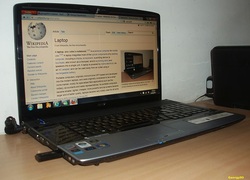
Conventionally, a computer consists of at least one processing element and some form of memory, which in computing, refers to the physical devices used to store programs or sequences of instructions) or data (e.g. program state information) on a temporary or permanent basis for use on a computer or other digital electronic device.
The processing element carries out arithmetic and logic operations and a sequencing and control unit that can change the order of operations based on stored information. Peripheral devices allow information to be retrieved from an external source, and the result of operations saved and retrieved.
The first electronic digital (data technology that uses discrete (discontinuous) values) computers were developed between 1940 and 1945 in the United Kingdom and United States. Originally, they were the size of a large room, consuming as much power as several modern personal computers (PCs). In this era, mechanical analog computers, a form of computer that uses the continuously changeable aspects of physical phenomena such as electrical, mechanical, or hydraulic quantities to model the problem being solved, were used for military applications.
Modern computers based on integrated circuits, or “monolithic integrated circuit” (also referred to as “IC,” “chip,” or “microchip”) is an electronic circuit manufactured by lithography, or the patterned diffusion of trace elements into the surface of a thin substrate of semiconductor material, are millions to billions of times more capable than the early machines. And also, occupy a fraction of the space.
Simple computers are small enough to fit into: mobile devices (also known as “handheld device,” handheld computer” or simply “handheld”), a small, hand-held computing device, typically having a display screen with touch input and/or a miniature keyboard and weighing less than two pounds (0.91 kg); and mobile computers, human-computer interaction by which a computer is expected to be transported during normal; usage. Both of them can be powered by small batteries, which in electricity, is a device consisting of one or more electrochemical cells that convert stored chemical energy into electrical energy.
Personal computers in their various forms are icons, or the “religious work of art, most commonly a painting, from Early christianity and in certain Eastern Catholic churches, of the Information Age, a period that will be characterized by the ability of individuals to transfer information freely, and to have instant access to information that would have been difficult or impossible to find previously. They are what most people think of as “computers.” However, the embedded computers, or computer systems designed for specific control functions within a larger system, often with real-time computing constraints, found in many devices from: mp3 players (“portable media players (“PMP”), or “digital audio player” (“DAP”), a consumer electronics device that is capable of storing and playing digital media such as audio, images, video, documents, etc. the data is typically stored on a hard drive, microdrive, or flash memory; to fighter aircraft, a military aircraft designed primarily for air-to-air combat against other aircraft, as opposed to bombers and attack aircraft, whose main mission is to attack ground targets; and from toys to industrial robots, defined by ISO, as an “automatically controlled, reprogrammable, multipurpose manipulator programmable in three or more axes,” are the most numerous.
See: Satellite Internet/Broadband
 RSS Feed
RSS Feed